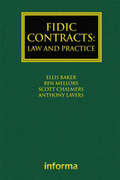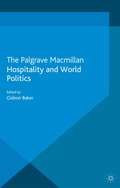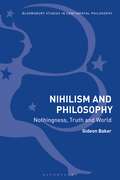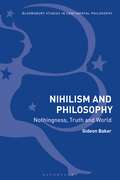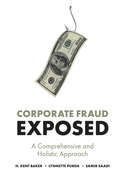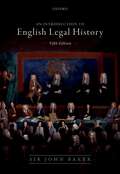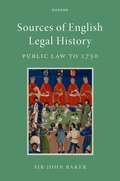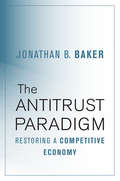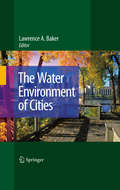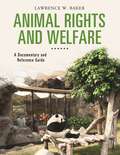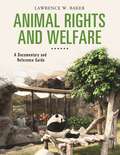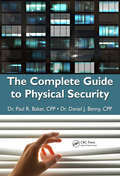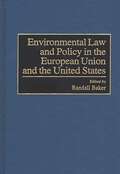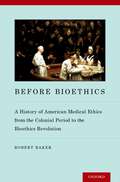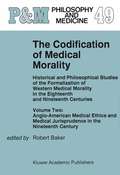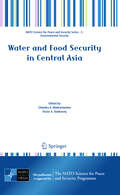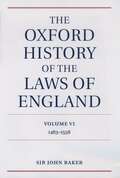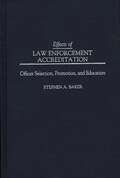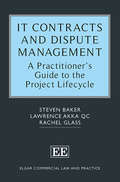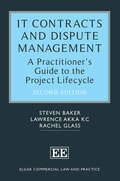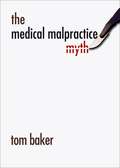- Table View
- List View
FIDIC Contracts: Law and Practice (Construction Practice Series)
by Ellis Baker Ben Mellors Scott Chalmers Anthony LaversFIDIC Contracts: Law and Practice is sure to become the leading industry standard guide to using the FIDIC forms, and is the only book to date which deals with the whole suites of contracts, including the new gold book for Design, Build and Operate projects. The White & Case work is outstanding in its detailed consideration and treatment of the legal aspects of the interpretation and application of the Conditions, touching on many points that most people would not have encountered. Humphrey LLoyd, International Construction Law Review [2010] ICLR 386
Environmental Law for Sustainable Construction: A guide for construction, engineering and architecture professionals
by Francine Baker Jennifer CharlsonEnvironmental Law for Sustainable Construction gives a practical overview of key areas of environmental law as it affects the construction sector. Clearly structured for ease of reference, the book provides coverage of core areas in a format that will help professionals and organisations to manage compliance issues relating to environmental law. It will also support the improvement of environmental protection and sustainable development. Coverage in the book includes: key areas of environmental regulation, including environmental impact and habitat assessments, climate change law, contaminated and brownfield land, waste management and water pollution an overview of the UK planning process, and environmental regulators and their powers environmental requirements on construction sites, and environment-related insurance matters proactive project checklists to facilitate compliance. Environmental Law for Sustainable Construction is suitable for a broad range of practitioners in the architecture, engineering and construction (AEC) industry who require a clear introduction and reference to help navigate the complexity in this area of law.
Hospitality and World Politics (Palgrave Studies in International Relations)
by Gideon BakerA long neglected concept in the field of international relations and political theory, hospitality provides a new framework for analysing many of the challenges in world politics today, from the search for peaceable relations between states to asylum and refugee crises.
Nihilism and Philosophy: Nothingness, Truth and World (Bloomsbury Studies in Continental Philosophy)
by Gideon BakerThe question of nihilism is always a question of truth.It is a crisis of truth that causes the experience of the nothingness of existence. What elevated truth to this existential position? The answer is: philosophy. The philosophical will to truth opens the door to nihilism, since it both makes identifying truth the utmost aim and yet continually calls it into question. Baker develops the central insight that the crises of truth and of existence, or 'loss of world', that occur within nihilistic thought are inseparable, in a wide-ranging study from antiquity to the present, from ancient Cynics, St Paul, Nietzsche, Heidegger, Foucault, Agamben, and Badiou.Baker contends that since nihilism is always a question of the relation to the world occasioned by the philosophical will to truth, an answer to nihilism must be able to propose a new understanding of truth.
Nihilism and Philosophy: Nothingness, Truth and World (Bloomsbury Studies in Continental Philosophy)
by Gideon BakerThe question of nihilism is always a question of truth.It is a crisis of truth that causes the experience of the nothingness of existence. What elevated truth to this existential position? The answer is: philosophy. The philosophical will to truth opens the door to nihilism, since it both makes identifying truth the utmost aim and yet continually calls it into question. Baker develops the central insight that the crises of truth and of existence, or 'loss of world', that occur within nihilistic thought are inseparable, in a wide-ranging study from antiquity to the present, from ancient Cynics, St Paul, Nietzsche, Heidegger, Foucault, Agamben, and Badiou.Baker contends that since nihilism is always a question of the relation to the world occasioned by the philosophical will to truth, an answer to nihilism must be able to propose a new understanding of truth.
Corporate Fraud Exposed: A Comprehensive and Holistic Approach
by H. Kent Baker Samir Saadi Lynnette PurdaAfter each major corporate scandal, new suggestions for combatting fraud emerge from regulators and industry professionals. Despite changes to guidelines for firms’ corporate governance, augmented protection for whistle blowers, and enhanced cybersecurity measures, evidence documents an alarming increase in the prevalence and severity of corporate fraud. The rapidly changing laws aimed at curbing corporate fraud sometimes lag behind the changing sophistication of fraud schemes. Corporate Fraud Exposed discusses the motivations and drivers of fraud including agency theory, executive compensation, and organizational culture. It examines fraud’s consequences for various firm stakeholders and its spillover effects to other corporations, the political environment, and financial market participants, including those who participate via crowdfunding platforms. This book provides a fresh look at this intriguing but often complex subject. It skillfully blends the contributions of a global array of scholars and practitioners into a single review of some of the most important topics in this area. Given its broad scope, this practical and comprehensive title should be of interest to anyone curious about corporate fraud.
Introduction to English Legal History
by John BakerFully revised and updated, this classic text provides the authoritative introduction to the history of the English common law. The book traces the development of the principal features of English legal institutions and doctrines from Anglo-Saxon times to the present and, combined with Baker and Milsom's Sources of Legal History, offers invaluable insights into the development of the common law of persons, obligations, and property, and also of criminal and public law. It is an essential reference point for all lawyers, historians and students seeking to understand the evolution of English law over a millennium. The book provides an introduction to the main characteristics, institutions, and doctrines of English law over the longer term - particularly the evolution of the common law before the extensive statutory changes and regulatory regimes of the last two centuries. It explores how legal change was brought about in the common law and how judges and lawyers managed to square evolution with respect for inherited wisdom.
Introduction to English Legal History
by John BakerFully revised and updated, this classic text provides the authoritative introduction to the history of the English common law. The book traces the development of the principal features of English legal institutions and doctrines from Anglo-Saxon times to the present and, combined with Baker and Milsom's Sources of Legal History, offers invaluable insights into the development of the common law of persons, obligations, and property, and also of criminal and public law. It is an essential reference point for all lawyers, historians and students seeking to understand the evolution of English law over a millennium. The book provides an introduction to the main characteristics, institutions, and doctrines of English law over the longer term - particularly the evolution of the common law before the extensive statutory changes and regulatory regimes of the last two centuries. It explores how legal change was brought about in the common law and how judges and lawyers managed to square evolution with respect for inherited wisdom.
Sources of English Legal History: Public Law to 1750
by John BakerSources of English Legal History: Public Law to 1750 is the definitive source book on the foundations of English public law. A companion to Baker and Milsom's Sources of English Legal History: Private Law to 1750 2e (OUP, 2010), this new volume offers an extensive collection of illustrative original materials, many of which are previously unpublished. It contains significant new material on the history of habeas corpus, mandamus, and certiorari, as well as well-known constitutional landmarks from the earliest times to 1750. Writing on the history of public law has tended to focus solely on the texts of statutes and formal records. In contrast, the present book concentrates on the forensic arguments and judicial decisions that led to the emergence of legal principles in the field of public law, including criminal law and the regulation of jurisdictions. It illuminates the growth of public law during the medieval and early modern periods, addressing the state's legislative and judicial organs, its coercive functions, and more broadly, the respective powers of the crown and parliament. The first work of its kind, this book is an essential resource for anyone interested in legal and constitutional history.
Sources of English Legal History: Public Law to 1750
by John BakerSources of English Legal History: Public Law to 1750 is the definitive source book on the foundations of English public law. A companion to Baker and Milsom's Sources of English Legal History: Private Law to 1750 2e (OUP, 2010), this new volume offers an extensive collection of illustrative original materials, many of which are previously unpublished. It contains significant new material on the history of habeas corpus, mandamus, and certiorari, as well as well-known constitutional landmarks from the earliest times to 1750. Writing on the history of public law has tended to focus solely on the texts of statutes and formal records. In contrast, the present book concentrates on the forensic arguments and judicial decisions that led to the emergence of legal principles in the field of public law, including criminal law and the regulation of jurisdictions. It illuminates the growth of public law during the medieval and early modern periods, addressing the state's legislative and judicial organs, its coercive functions, and more broadly, the respective powers of the crown and parliament. The first work of its kind, this book is an essential resource for anyone interested in legal and constitutional history.
The Antitrust Paradigm: Restoring a Competitive Economy
by Jonathan B. BakerAt a time when tech giants have amassed vast market power, Jonathan Baker shows how laws and regulations can be updated to ensure more competition. The sooner courts and antitrust enforcement agencies stop listening to the Chicago school and start paying attention to modern economics, the sooner Americans will reap the benefits of competition.
The Water Environment of Cities
by Lawrence A. BakerThe concept for the Water Environment of Cities arose from a workshop “Green 1 Cities, Blue Waters” workshop held in 2006. The workshop assembled experts from engineering, planning, economics, law, hydrology, aquatic ecology, geom- phology, and other disciplines to present research ?ndings and identify key new ideas on the urban water environment. At a lunch discussion near the end of the workshop, several of us came to the recognition that despite having considerable expertise in a narrow discipline, none of us had a vision of the “urban water en- ronment” as a whole. We were, as in the parable, blind men at opposite ends of the elephant, knowinga great deal about the parts, but notunderstandingthe whole. We quickly recognized the need to develop a book that would integrate this knowledge to create this vision. The goal was to develop a book that could be used to teach a complete, multidisciplinary course, “The Urban Water Environment”, but could also be used as a supplemental text for courses on urban ecosystems, urban design, landscapearchitecture,water policy,waterqualitymanagement andwatershed m- agement. The book is also valuable as a reference source for water professionals stepping outside their arena of disciplinary expertise. The Water Environment of Cities is the ?rst book to use a holistic, interdis- plinary approach to examine the urban water environment. We have attempted to portrayaholisticvisionbuiltaround theconcept of water as a coreelement ofcities. Water has multipleroles:municipalwatersupply,aquatichabitat,landscapeaesth- ics, and recreation. Increasingly, urban water is reused, serving multiple purposes.
Animal Rights and Welfare: A Documentary and Reference Guide (Documentary and Reference Guides)
by Lawrence W. BakerThrough the use of primary source documents, readers can learn about key opinions and legislation in the important field of animal rights and welfare—a current and highly relevant topic.Animal Rights and Welfare: A Documentary and Reference Guide addresses a broad range of key topics within the subject of animal rights and welfare, including zoos, animal testing, philosophy regarding the treatment of animals, and practical measures instituted to protect animals, supplying readers with an impartial and authoritative resource for understanding the history of animal rights and the issues that dominate discussions about animal rights. Organized chronologically, the book discusses topics such as animal rights within the context of hunting for food, pelts, and other body parts, as well as for recreation; working animals; animals used for education or scientific and medical research; animals in the fashion and entertainment industries; and the food industry.The text provides reproductions of dozens of carefully selected primary documents from the time of Aristotle (B.C.) to present day to engage readers and provide opportunities for them to apply their critical thinking and analysis skills. The text of each document is introduced by a headnote to place it in context and concludes with analysis that details its significance and clarifies specific passages when needed. Each document or excerpt is followed by a full citation of the document.
Animal Rights and Welfare: A Documentary and Reference Guide (Documentary and Reference Guides)
by Lawrence W. BakerThrough the use of primary source documents, readers can learn about key opinions and legislation in the important field of animal rights and welfare—a current and highly relevant topic.Animal Rights and Welfare: A Documentary and Reference Guide addresses a broad range of key topics within the subject of animal rights and welfare, including zoos, animal testing, philosophy regarding the treatment of animals, and practical measures instituted to protect animals, supplying readers with an impartial and authoritative resource for understanding the history of animal rights and the issues that dominate discussions about animal rights. Organized chronologically, the book discusses topics such as animal rights within the context of hunting for food, pelts, and other body parts, as well as for recreation; working animals; animals used for education or scientific and medical research; animals in the fashion and entertainment industries; and the food industry.The text provides reproductions of dozens of carefully selected primary documents from the time of Aristotle (B.C.) to present day to engage readers and provide opportunities for them to apply their critical thinking and analysis skills. The text of each document is introduced by a headnote to place it in context and concludes with analysis that details its significance and clarifies specific passages when needed. Each document or excerpt is followed by a full citation of the document.
The Complete Guide to Physical Security
by Paul R. Baker Daniel J. BennyTo adequately protect an organization, physical security must go beyond the "gates, guns, and guards" mentality that characterizes most security programs. Creating a sound security plan involves understanding not only security requirements but also the dynamics of the marketplace, employee issues, and management goals. The Complete Guide to Physica
The Complete Guide to Physical Security
by Paul R. Baker Daniel J. BennyTo adequately protect an organization, physical security must go beyond the "gates, guns, and guards" mentality that characterizes most security programs. Creating a sound security plan involves understanding not only security requirements but also the dynamics of the marketplace, employee issues, and management goals. The Complete Guide to Physica
Environmental Law and Policy in the European Union and the United States (Non-ser.)
by Randall BakerAuthorities in the fields of environmental and international law and policy, political science, environmental technology, and public administration compare and contrast the ways in which the United States and the European Union handle similar environmental issues.The contributors critically analyze the influence of culture and history on the way apparently similar developed democracies handle the same problems; they examine the center-state relationship as it applies to EU member countries in contrast to states within the United States; they look at the challenge of transboundary, international, and global environmental problems, and how these relate to the still-emerging geopolitical reconfigurations involved in such structures as NAFTA and the EU; and they examine how transnational resources are handled in the North American and EU contexts. Randall Baker has assembled leading experts who examine significant issues for policymakers and environmentalists in North America and Western Europe.
Before Bioethics: A History of American Medical Ethics from the Colonial Period to the Bioethics Revolution
by Robert BakerBefore Bioethics narrates the history of American medical ethics from its colonial origins to current bioethical controversies over abortion, AIDS, animal rights, and physician-assisted suicide. This comprehensive history tracks the evolution of American medical ethics over four centuries, from colonial midwives and physicians' oaths to medical society codes, through the bioethics revolution. Applying the concept of "morally disruptive technologies," it analyzes the impact of the stethoscope on conceptions of fetal life and the criminalization of abortion, and the impact of the ventilator on our conception of death and the treatment of the dying. The narrative offers tales of those whose lives were affected by the medical ethics of their era: unwed mothers executed by puritans because midwives found them with stillborn babies; the unlikely trio-an Irishman, a Sephardic Jew and in-the-closet gay public health reformer-who drafted the American Medical Association's code of ethics but received no credit for their achievement, and the founder of American gynecology celebrated during his own era but condemned today because he perfected his surgical procedures on un-anesthetized African American slave women. The book concludes by exploring the reasons underlying American society's empowerment of a hodgepodge of ex-theologians, humanist clinicians and researchers, lawyers and philosophers-the bioethicists-as authorities able to address research ethics scandals and the ethical problems generated by morally disruptive technologies. To access the companion website for Before Bioethics: A History of American Medical Ethics from the Colonial Period to the Bioethics Revolution, please visit: http://global.oup.com/us/companion.websites/9780199774111/
The Codification of Medical Morality: Historical and Philosophical Studies of the Formalization of Western Medical Morality in the Eighteenth and Nineteenth CenturiesVolume Two: Anglo-American Medical Ethics and Medical Jurisprudence in the Nineteenth Century (Philosophy and Medicine #49)
by Robert Baker Dorothy Porter Roy PorterLike many novel ideas, the idea for this volume and its predecessor arose over lunch in the cafeteria of the old Wellcome Institute. On an atternoon in Sept- ber 1988, Dorothy and Roy Porter, and I, sketched out a plan for a set of conf- ences in which scholars from a variety of disciplines would explore the emergence of modern medical ethics in the English-speaking world: from its pre-history in the quarrels that arose as gentlemanly codes of etiquette and honor broke down under the pressure of the eighteenth-century "sick trade," to the Enlightenment ethics of John Gregory and Thomas Percival, to the American appropriation process that culminated in the American Medical Association's 1847 Code of Ethics, and to the British turn to medical jurisprudence in the 1858 Medical Act. Roy Porter formally presented our idea as a plan for two back-to-back c- ferences to the Wellcome Trust, and I presented it to the editors of the PHI- LOSOPHY AND MEDICINE series, H. Tristram Engeihardt, Jr. and Stuart Spicker. The reception from both parties was enthusiastic and so, with the financial backing of the former and a commitment to publication from the latter, Roy Porter, ably assisted by Frieda Hauser and Steven Emberton, - ganized two conferences. The first was held at the Wellcome Institute in - cember 1989; the second was sponsored by the Wellcome, but was actually held in the National Hospital, in December 1990.
Water and Food Security in Central Asia (NATO Science for Peace and Security Series C: Environmental Security)
by Robert S. Baker I. Helen FylesCentral Asia is vulnerable to water scarcity because it is located in semiarid and arid vegetation zones and large parts of its economy depend on water for irrigation and energy. Climate-change scenarios predict temperature increases and a rising number of extreme weather events, which will exacerbate water shortages in the future. In addition, the population of Central Asia is growing more rapidly than the rate of food production which is resulting in food insecurity in many parts of the region too. This volume reports the deliberations of politicians, scientists and representatives of water management organizations from throughout Central Asia. Their contributions not only highlight areas of concern, but also propose numerous ideas for improving the long-term water- and food security in the region.
The Oxford History of the Laws of England Volume VI: 1483-1558 (The Oxford History of the Laws of England Series isbn 0-19-961352-4)
by Sir John BakerThis volume covers the years 1483-1558, a period of immense social, political, and intellectual changes, which profoundly affected the law and its workings. It first considers constitutional developments, and addresses the question of whether there was a rule of law under king Henry VIII. In a period of supposed despotism, and enhanced parliamentary power, protection of liberty was increasing and habeas corpus was emerging. The volume considers the extent to which the law was affected by the intellectual changes of the Renaissance, and how far the English experience differed from that of the Continent. It includes a study of the myriad jurisdictions in Tudor England and their workings; and examines important procedural changes in the central courts, which represent a revolution in the way that cases were presented and decided. The legal profession, its education, its functions, and its literature are examined, and the impact of printing upon legal learning and the role of case-law in comparison with law-school doctrine are addressed. The volume then considers the law itself. Criminal law was becoming more focused during this period as a result of doctrinal exposition in the inns of court and occasional reports of trials. After major conflicts with the Church, major adjustments were made to the benefit of clergy, and the privilege of sanctuary was all but abolished. The volume examines the law of persons in detail, addressing the impact of the abolition of monastic status, the virtual disappearance of villeinage, developments in the law of corporations, and some remarkable statements about the equality of women. The history of private law during this period is dominated by real property and particularly the Statutes of Uses and Wills (designed to protect the king's feudal income against the consequences of trusts) which are given a new interpretation. Leaseholders and copyholders came to be treated as full landowners with rights assimilated to those of freeholders. The land law of the time was highly sophisticated, and becoming more so, but it was only during this period that the beginnings of a law of chattels became discernible. There were also significant changes in the law of contract and tort, not least in the development of a satisfactory remedy for recovering debts.
Effects of Law Enforcement Accreditation: Officer Selection, Promotion, and Education (Non-ser.)
by Stephen A. BakerFor many years, law enforcement administrators, government officials, and researchers have explored the possibility of professionalizing law enforcement agencies and their officers. Some have called for mandatory college education requirements while others have argued for the formation of a national police force. In 1979, police practitioners from various law enforcement executive organizations met to develop a process to professionalize police agencies by instituting standards covering the wide range of police functions. The Commission on Accreditation for Law Enforcement Agencies, Inc. (CALEA) was born. This book describes the results of a study that evaluated the impact of CALEA accreditation on specific personnel administration practices in municipal police departments. The author compares accredited and non-accredited departments for personnel practices including procedures for officer selection, promotion, and the integration of formal education requirements.
IT Contracts and Dispute Management: A Practitioner’s Guide to the Project Lifecycle (Elgar Commercial Law and Practice series)
by Steven Baker Lawrence Akka Rachel GlassIT Contracts and Dispute Management provides in-depth analysis of the legal issues that customers and suppliers involved in a technology project can face at each of its critical stages. The authors offer a practitioner’s-eye view of both the impact of those issues and how to resolve them or minimise their effect. Key features include: • guidance on all stages of a technology project presented in the order in which they typically occur • discussion of the tender process, preparation of contract terms and project delivery • advice on how to manage commonly occurring issues, such as delayed delivery • insight into potential methods of project ‘resuscitation’ when difficulties arise • advice on ‘end of project’ issues, including termination options, formal resolution of disputes and quantification of losses • first-hand insights drawing on the authors’ extensive personal experiences throughout. This new work is the first thorough examination of the legal framework underpinning IT contracts and technology projects. It focuses on English contract law as it applies in this specific context, but combines a detailed legal analysis of common law principles with commercial and tactical guidance, making it suitable for lawyers worldwide. It will be a valuable resource for lawyers in private practice who are advising clients on the avoidance or resolution of disputes arising from IT projects, and to in-house legal counsel who advise on the procurement, supply, or management of IT projects.
IT Contracts and Dispute Management: A Practitioner’s Guide to the Project Lifecycle (Elgar Commercial Law and Practice series)
by Steven Baker Lawrence Akka Rachel GlassThis thoroughly revised and expanded second edition of IT Contracts and Dispute Management provides an in-depth analysis of the legal issues that could potentially arise within each critical stage of a technology project. The authors draw on their extensive practical experience of advising and litigating in this evolving field, and have produced a work that is both authoritative and pragmatic.Key Features:Discussion of recent judicial decision of relational contracts, and the Supreme Court’s judgment on ‘no oral modification’ clauses and their applicability to change control proceduresUpdated information to account for the new High Court rules on disclosureGuidance on how to manage frequently occurring issues, such as delayed deliveryExamination of important methods of project resuscitation when experiencing difficulty, as well as potential end of project issuesThis informative book will be a hugely valuable resource for lawyers in private practice who are advising clients striving to avoid or resolve disputes occurring from IT projects. It will also be beneficial for in-house legal counsel who advise clients at each stage of IT projects.
The Medical Malpractice Myth (The\chicago Ser. On Sexuality, History, And Society Ser.)
by Tom BakerAmerican health care is in crisis because of exploding medical malpractice litigation. Insurance premiums for doctors and malpractice lawsuits are skyrocketing, rendering doctors both afraid and unable to afford to continue to practice medicine. Undeserving victims sue at the drop of a hat, egged on by greedy lawyers, and receive eye-popping awards that insurance companies, hospitals, and doctors themselves struggle to pay. The plaintiffs and lawyers always win; doctors, and the nonlitigious, always lose; and affordable health care is the real victim. This, according to Tom Baker, is the myth of medical malpractice, and as a reality check he offers The Medical Malpractice Myth, a stunning dismantling of this familiar, but inaccurate, picture of the health care industry. Are there too many medical malpractice suits? No, according to Baker; there is actually a great deal more medical malpractice, with only a fraction of the cases ever seeing the inside of a courtroom. Is too much litigation to blame for the malpractice insurance crisis? No, for that we can look to financial trends and competitive behavior in the insurance industry. Are these lawsuits frivolous? Very rarely. Point by point, Baker—a leading authority on insurance and law—pulls together the research that demolishes the myths that have taken hold about medical malpractice and suggests a series of legal reforms that would help doctors manage malpractice insurance while also improving patient safety and medical accountability. President Bush has made medical malpractice reform a priority in his last term in office, but if history is any indication, legislative reform would only worsen the situation and perpetuate the gross misunderstanding of it. The debate surely will be transformed by The Medical Malpractice Myth, a book aimed squarely at general readers but with radical conclusions that speak to the highest level of domestic policymaking.
